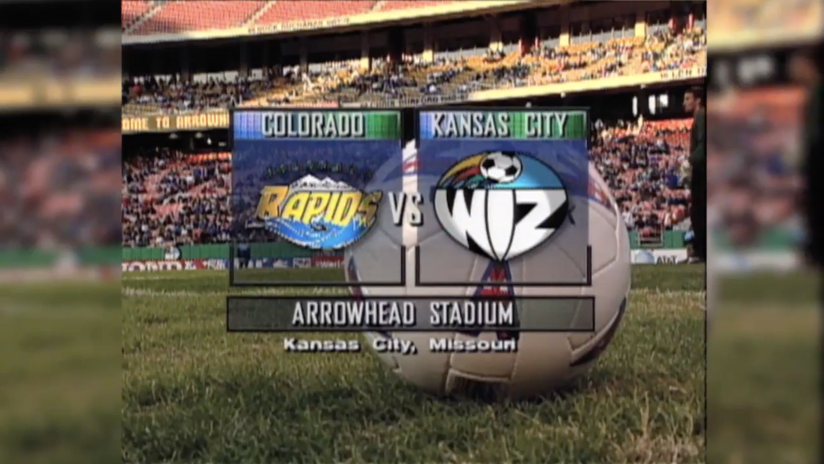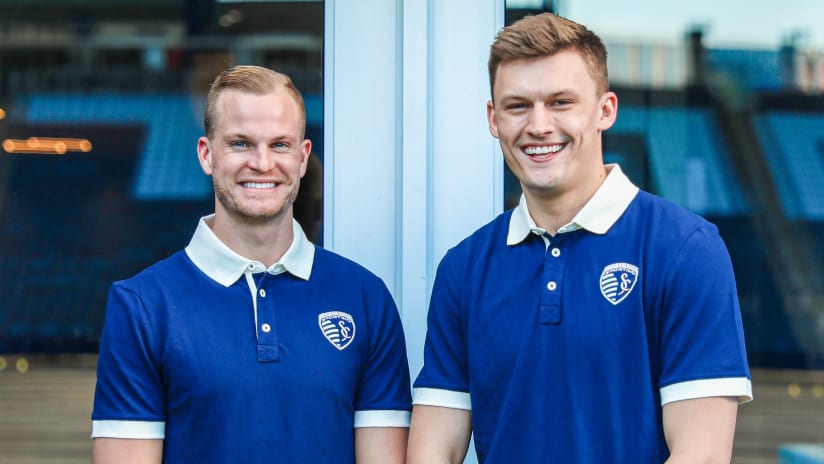Sporting Kansas City celebrates the club's 25th season this year as one of 10 original teams when Major League Soccer kicked off in April 1996. SportingKC.com is looking back at 25 moments that led up to our inaugural match in a seven-part special series. Click here for Part I.
Sept. 28, 1990
Arrowhead Stadium opened on Aug. 12, 1972. In its first 18 years, it would host only one major soccer match: an exhibition between the North American Soccer League All-Stars, coached by Gordon Bradley*, and reigning USSR Cup champions Torpedo Moscow on Aug. 24, 1973.
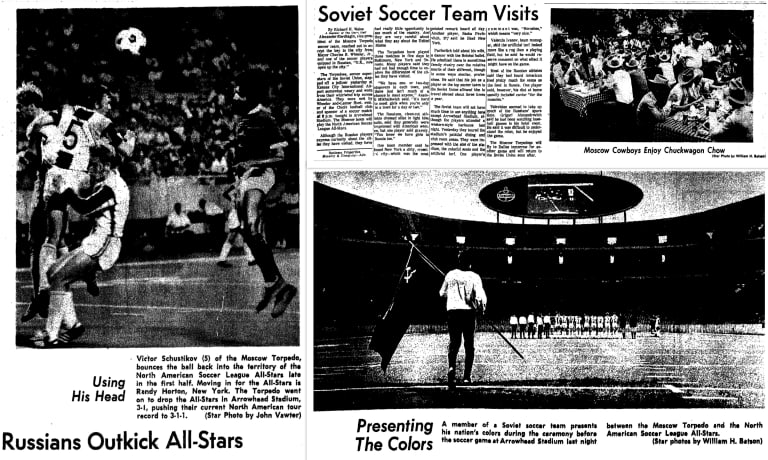
In front of 6,832 fans, National Soccer Hall of Famer Paul Child scored the lone goal for the NASL All-Stars in a 3-1 defeat.
*Bradley would coach the U.S. Men’s National Team in their final five games of 1973 and became the only player-coach in U.S. MNT history upon suiting up against Israel on Nov. 15, 1973, a friendly in which Bruce Arena earned his only cap.
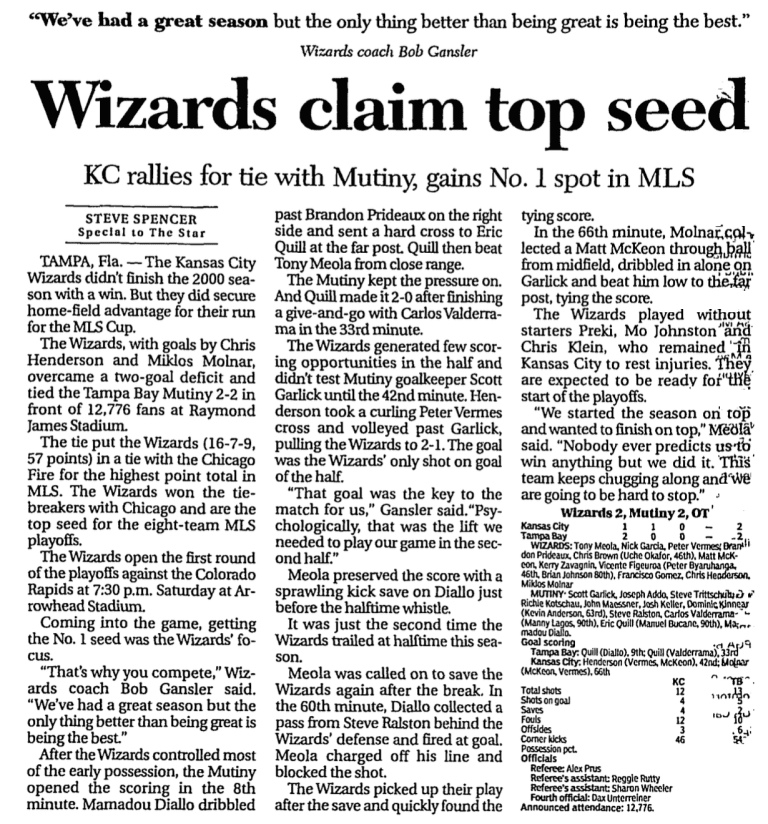
Fast forward to Sept. 28, 1990 and soccer returned to the Truman Sports Complex with one of the most unusual matches in American soccer history. The U.S. MNT, coming off their first World Cup appearance in 40 years, took the field at Arrowhead Stadium against an unlikely opponent: an indoor all-star team from the newly rebranded Major Soccer League, headquartered in Overland Park and home to the Kansas City Comets.
The coaches? The MSL Select team was led by Ron Newman, Sporting’s first head coach (1996-1999) who was in the midst of winning five straight indoor championships, and the U.S. was under the guidance of Bob Gansler, Sporting’s second head coach (1999-2006) and an inaugural member in Sporting Legends.
The rosters also offered a strong foreshadowing for the future of pro outdoor soccer in Kansas City.
Preki (1996-2000, 2002-05), a two-time MLS MVP in KC, headlined the indoor squad along with Paul Wright (1996-1999) and Chico Borja (coaching assistant in 1996), while the U.S. MNT boasted Peter Vermes (2000-02), Brian Bliss (1998) and Eric Eichmann (1996).

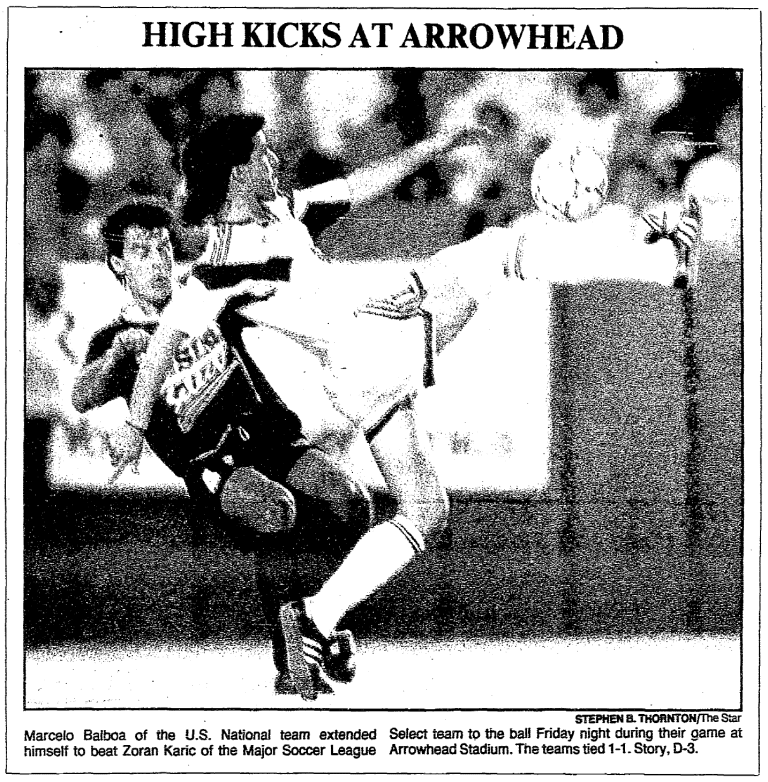
Incredibly, the MSL Select team held the U.S. MNT to a 1-1 draw on the artificial turf at Arrowhead with an announced attendance of 10,161. The Kansas City Comets’ own Ted Eck opened the scoring in the 18th minute before Bruce Murray equalized for the U.S. MNT in the 42nd minute on an indirect free kick from eight yards out after World Cup referee Vincent Mauro called the MSL goalkeeper for holding onto the ball too long.
The teams would meet again two days later at Soccer Park in Fenton, Missouri with the national team capping off the Budweiser Challenge Cup with a 2-0 victory in the rematch on a pair of goals from Vermes. The current Sporting KC Manager and Sporting Director scored in the third minute after a misplay by the indoor goalkeeper on a long throw and then won a PK and converted the penalty in the 87th minute. A full replay of the match, as shown on SportsChannel America, is available on YouTube.
“Officials from the MSL and the U.S. Soccer Federation hope the two-game series will be the first step in the development of a professional outdoor league,” read the Associated Press report in the Kansas City Star on Oct. 1, 1990.
May 15-16, 1991 and July 10, 1991
The MSL’s best players would return to Kansas City for the MSL All-Star Game on Feb. 13, 1991 and representatives from U.S. Soccer would also be headed to KC in search of a new destination for U.S. Soccer’s national offices - at the time located at the U.S. Olympic complex in Colorado Springs.
The federation sent Kevin Payne and Dr. Robert Contiguglia to Kansas City from May 15-16, 1991 followed by a visit from President Alan Rothenberg and Executive Director Hank Steinbrecher on July 10, 1991 to evaluate Truman Sports Complex as a potential site.
How might that have impacted a future pro soccer franchise in Kansas City?
The proposal included a 20,000-seat stadium – to be built in four phases with 5,000 seats added in each phase – as well as an office complex and an extra training field. Kansas City architecture firm HOK formulated the plans and estimated a cost of $6 million to complete the initial phase of construction as early as Fall 1992 on a plot of land due west of Arrowhead Stadium.
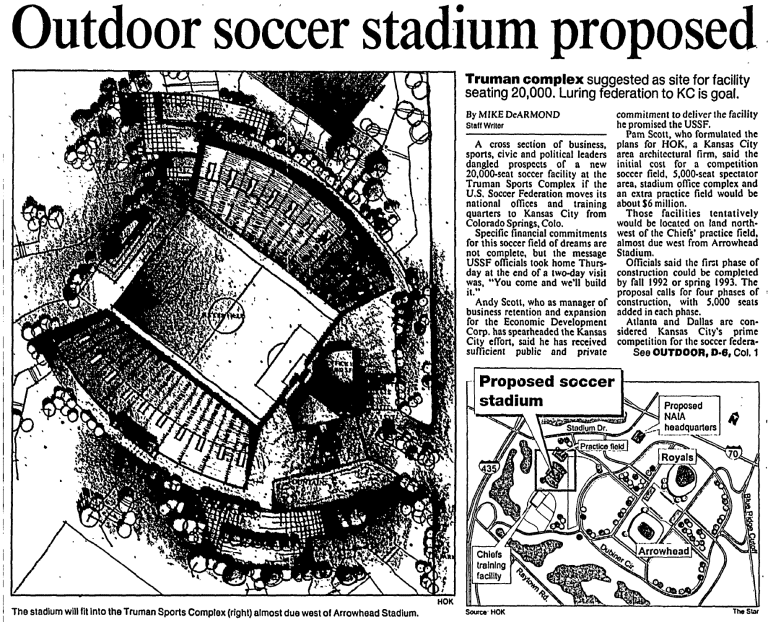
“Nobody else is offering this kind of facility,” Payne said. “Nobody else has a couple of hundred acres sitting around that they can build this kind of facility on.”
Nevertheless, U.S. Soccer announced Chicago – Steinbrecher’s place of residence – as the federation’s new home on July 30, 1991 and the sport’s governing body has been located in the windy city since moving in to U.S. Soccer House in December 1991.
U.S. Soccer’s decision came two weeks after the Kansas City Comets ceased operations after a decade at Kemper Arena during a string of four soccer-related setbacks for KC in a span of 21 months. In June 1990, U.S. Youth Soccer selected the Dallas suburb of Richardson, Texas as their new headquarters after naming KC a finalist along with Indianapolis and Tulsa. And in March 1992, FIFA picked nine venues from among the 19 finalists for the 1994 World Cup. KC failed to make the cut, but the tide would soon turn.
The National Soccer Coaches Association of America announced the selection of Kansas City for their national office in April 1992, moving the organization's headquarters from Pennsylvania, and the Kansas City Attack, after arriving to town in September 1991, would win a National Professional Soccer League title on April 30, 1993.
Dec. 17, 1993
The long-awaited debut of Major League Soccer.
In the days after FIFA awarded the 1994 World Cup to the United States in July 1988, U.S. Soccer President Werner Fricker told media he hoped a new outdoor professional soccer league could start in 1989.
Four years came and went.
"We said to FIFA: 'Let's do the World Cup things first. Don't force us to get the league running beforehand, because that would be a huge mistake,’” said Rothenberg.
"There was no set date for a pro league," Sepp Blatter, the general secretary of FIFA, said in June 1993, "but now we have insisted that by December we have a project in our hands."
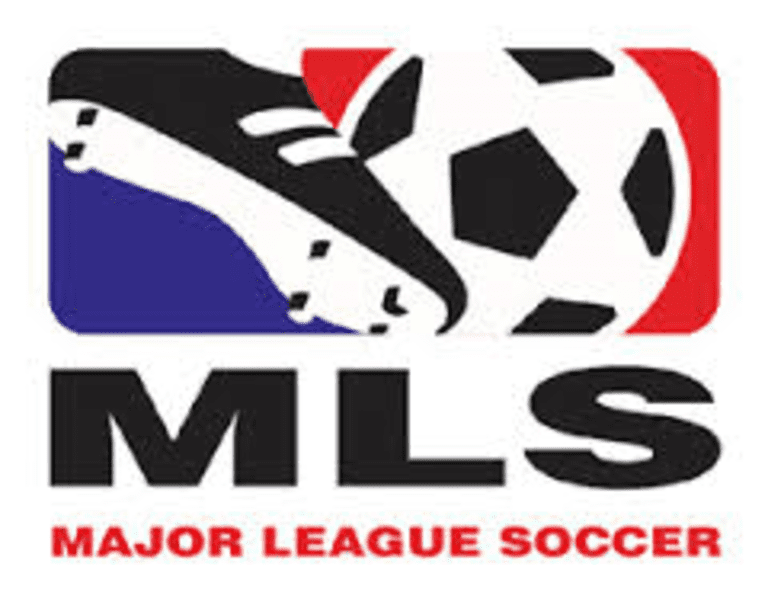
Eight days before Christmas, Major League Soccer’s logo was unwrapped and plans for a 12-team professional league to begin play in April 1995 were presented to FIFA in conjunction with the World Cup draw in Las Vegas.
“It was a very exciting time,” said MLS President Mark Abbott, who was a senior vice president for business development at the time. “There was a FIFA executive committee meeting where Alan presented the basic business plan for what became MLS. And immediately after that, we went into a press conference where Alan announced that FIFA had reviewed and approved the plan that we had put in place for what ultimately would become the league.”
Abbott told MLSsoccer.com that five national design firms were commissioned for the creation of the league logo, which endured with occasional modifications until the league’s 20th season in 2015.
Jan. 22-24, 1994
In the weeks after introducing Major League Soccer to an American soccer audience, league officials began the process of identifying prospective markets for MLS clubs.
Chief Operating Officer Bill Sage told The Arizona Republic there were a total of 38 cities on the league’s initial franchise list, which grew to 43 locations by the time marketing materials were created. Abbott told The Cincinnati Enquirer that “letters of intent from those who want a franchise” were due Jan. 15, 1994.
A week later, MLS hosted a Bidders Conference in Santa Monica in conjunction with a U.S. Men’s National Team friendly against Switzerland on Jan. 22, 1994 at Titan Stadium on the campus of Cal State Fullerton.
In attendance were representatives from 29 hopeful homes for MLS teams, gathered to learn more about the process and guidelines for securing a franchise.
Atlanta, Boston, Buffalo, Charlotte, Chicago, Cleveland, Columbus, Dallas, Denver, Detroit, Houston, Indianapolis, Kansas City, Los Angeles, Memphis, Miami, Milwaukee, New York/New Jersey, New Orleans, Orlando, Phoenix, Pittsburgh, Portland, Sacramento, St. Louis, San Francisco, Seattle, Tulsa, Washington, D.C.
Bidders were told MLS would expect each market to sell a minimum of 10,000 season ticket deposits and to have plans in place for a local training facility as well as the use, or construction of, a 20,000-30,000 seat stadium.
“I am very pleased that so many communities chose to participate in the meeting,” said Sage. “We are asking these people to respond to our specifications package by May 15, so that we can be in a position to name the franchise cities prior to the World Cup.”
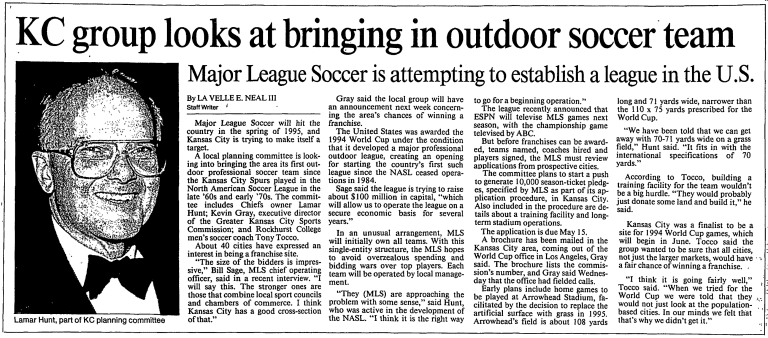
April 1, 1994
"Kansas City stands a great chance."
Those were Sage’s words during a press event on March 29 at Arrowhead Stadium as the NFL venue was confirmed as the centerpiece of Kansas City’s application to MLS.
The Kansas City Organizing Committee, co-chaired by Herb Kohn (Bryan Cave law firm) and Drue Jennings (Kansas City Power & Light), featured dozens of leaders in the local sports community, including Lamar Hunt (Kansas City Chiefs), Kevin Gray (Kansas City Sports Commission), Tony Tocco (Rockhurst University), Jim Sheldon (National Soccer Coaches Association of America) and Steve Bartel (Blue Valley Soccer Club).
Together, the group was tasked with the challenge of meeting Major League Soccer’s request for 10,000 season ticket pledges to demonstrate local support and interest.
So on April 1, 1994, the push began. Buy our town a Major League Soccer team. Buy your family a Major League Soccer team. Buy your kids a Major League Soccer team. Pledge to pay a deposit ($75 for adults, $35 for youth) for a season ticket and help bring a new professional sports franchise to KC.
Mailings went to Chiefs season ticket holders. Advertisements ran in the Kansas City Star and on local TV. Youth soccer organizations rallied behind the campaign.
But by the May 10 cut off, only 2,000 pledges were in place. When MLS extended the deadline for season ticket sales to June 3, KC concluded with 2,700 commitments.
Fortunately, Kansas City wasn’t alone. Only organizers in Tulsa, Oklahoma and Columbus, Ohio reportedly reached the desired 10,000 season ticket threshold.
"We'll be on the bubble somewhere," Sheldon said. “We’re close.”
Close to the competition? Very much so.
Close to a verdict from MLS? Well, not quite.
The twists and turns in the make-or-break year ahead are next in our 25th season retrospective as SportingKC.com reflects on 25 moments that set the stage for Kansas City's MLS debut on April 13, 1996.

